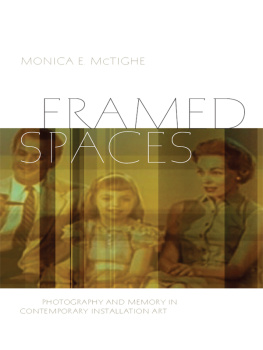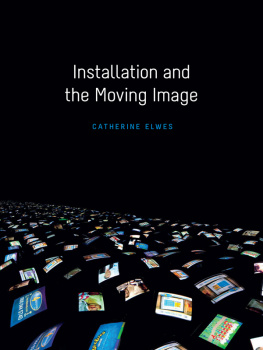INTERFACES : Studies in Visual Culture
EDITORS: Mark J. Williams and Adrian W. B. Randolph, Dartmouth College
This series, sponsored by Dartmouth College Press, develops and promotes the study of visual culture from a variety of critical and methodological perspectives. Its impetus derives from the increasing importance of visual signs in everyday life, and from the rapid expansion of what are termed new media. The broad cultural and social dynamics attendant to these developments present new challenges and opportunities across and within the disciplines. These have resulted in a trans-disciplinary fascination with all things visual, from high to low, and from esoteric to popular. This series brings together approaches to visual culture broadly conceived that assess these dynamics critically and that break new ground in understanding their effects and implications.
For a complete list of books that are available in the series, visit www.upne.com.
Monica E. McTighe, Framed Spaces: Photography and Memory in Contemporary Installation Art
Alison Trope, Stardust Monuments: The Saving and Selling of Hollywood
Nancy Anderson and Michael R. Dietrich, eds., The Educated Eye: Visual Culture and Pedagogy in the Life Sciences
Shannon Clute and Richard L. Edwards, The Maltese Touch of Evil: Film Noir and Potential Criticism
Steve F. Anderson, Technologies of History: Visual Media and the Eccentricity of the Past
Dorothe Brill, Shock and the Senseless in Dada and Fluxus
Janine Mileaf, Please Touch: Dada and Surrealist Objects after the Readymade
Acknowledgments
This project could not have been completed without the help and support of many people. First, a great debt of gratitude is owed Howard Singerman, my mentor and advisor, whose persistent and generous support of my work has helped me in countless ways. In addition, I am grateful to the professors in the Department of Art History at the University of Virginia who helped me develop this project, providing financial support and guidance. Thanks are owed as well to the Department of Art and Art History at Tufts University and the Faculty Research Awards Committee at Tufts University whose generous moral and financial support of my work has helped me complete this project. In particular, I need to thank my colleague, Eric Rosenberg who has been a steadfast and generous mentor throughout my time at the university. Thank you to the knstlerhaus bchsenhausen in Innsbrck, Austria, which provided me with a fellowship that contributed to the work in this book. Additional thanks are due to my colleagues Gregory Williams and Benjamin Carp, who read drafts of the chapters, Leslie K. Brown, and Richard Pult and Amanda Dupuis of the University Press of New England. And much gratitude goes to the artists and others who have been so generous with their time, knowledge, patience, and support, including Tony Cokes, Rene Green, and Javier Anguera, Ann Hamilton, and Louise Lawler, as well as Janelle Reiring at Metro Pictures. Thank you to David Karp, who has been by my side through thick and thin. And last but not least, thank you to my family, especially to my father, E. James McTighe, and my sister, Michele Kendall, who have helped me in innumerable ways to complete this work. This is for you.
Monica E. McTighe
SOMERVILLE, MASSACHUSETTS, 2011
Introduction
Across the dark space, two transparent silk chambers float side by side above oily cement floors in the recently vacated spinning mill. Through the silk panels of each chamber, the observer can see the silhouettes of two long tables. On each table, video projectors, mounted on a turning mechanism, cast on the thin silk the image of a line being drawn by a pencil. The space is large, covering a half-acre with a ceiling supported by metal columns arranged in a grid pattern. The projections sweep around this vast space sometimes chasing each other, sometimes crossing each other. An image falls on the silk screens, splits into two, converges with the second projection, and shatters into four. As the viewer stands there, the sound of the pencil hissing on the paper fills the humid Virginia air and the pencils sweep across the viewers body, the forest of metal columns supporting the ceiling, and finally the cinderblock walls of the empty spinning mill.
Later, when the viewer sees photographs of this installation, ghost: a border act (2000), in a retrospective catalog of the artist Ann Hamiltons work, they do not capture the complexity of her experience of the installation. The reproduced photograph, thin, bounded clearly by its edge, and difficult to read because of the dim light in the space, seems to bear little relationship to the installation that the viewer saw and experienced. Photographs, however, are necessary for a historian of site-specific installation art, as her object of research once exhibited often no longer exists, having been disassembled and stored, or dispersed. Fortunately, many installations are photographed, and in the course of their research historians study these photographs carefully.
Although installation art is often assumed to be an art of direct experience, it is often mediated by photography. If installation art requires the presence of a viewer, what does it mean when the majority of viewers see them only in photographs? As scholars have found, the history of ephemeral art objects and events, such as installation art, is filtered through the memories of the people who saw them first hand. These memories are often solidified or distorted by the documentation that is published alongside the work. Photographs mediate memory; history is a representation often constructed from these bits of evidence.
For instance, with Ann Hamiltons ghost: a border act, the viewer went on to write about this installation. A television show titled Art: 21, Art in the Twenty-First Century was broadcast on the Public Broadcasting Service in the United States and showed videotape of the installation, as well as interviews with the artist. These fragments of the work of art may then end up in a textbook via the circuitous routes of memory, word of mouth, art review, and brief catalog description. The few photographs and videotapes of these events are often embroidered by memory, which transforms the work into myth, distancing it from the history of the event. A student in an art history lecture hall is provided with a distilled and perhaps distorted verbal description with a single photograph of an art installation. In one of the earliest accounts of installation art as a category, Julie Reiss advocates careful consideration of historical sources to counteract the transformation of history into myth. She encourages scholars to critically analyze personal accounts, press reviews, interviews with artists, and archival evidence, such as photographic documentation.
This book examines ways in which installation art, photography, and memory are intertwined with one another. Photography has shaped our understanding of history and memory since the nineteenth century. In the last forty years, a time in which the issue of memory has become of great interest in art practice and society in general, the theory of photography and photographic practice has become even more important in contemporary art. At the same time, installation art has become one of the ubiquitous, often criticized, mtiers in contemporary art practice.
Ephemeral installations that are concerned with the physical limits and material qualities of a site and interested in the viewers perceptions would seem to elude representation through photographs. It is natural to think then that photographs of these works are both lacking and supplementary to the work itself. However, most installations are photographed. Amelia Jones notes








